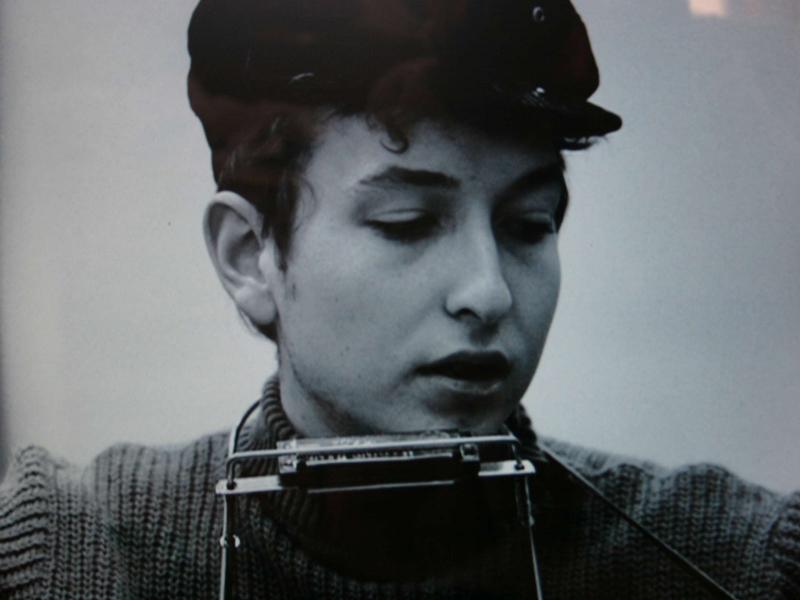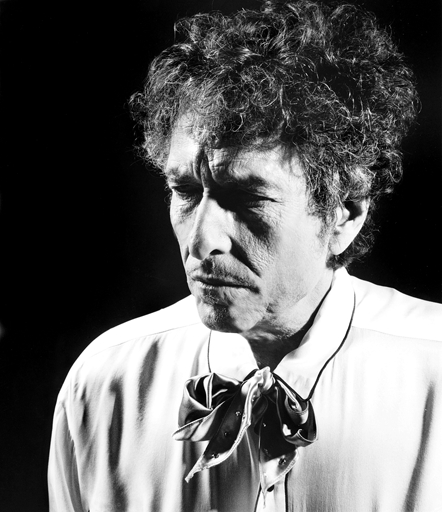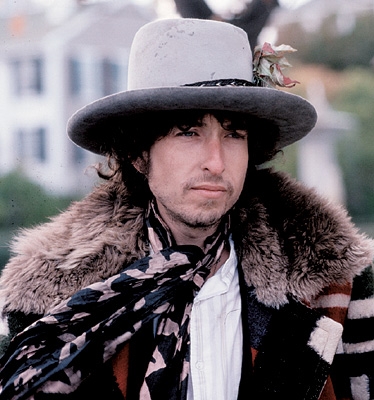Bob Dylan: Portrait of the Artist | reviews, news & interviews
Bob Dylan: Portrait of the Artist
Bob Dylan: Portrait of the Artist
With the imminent arrival of the 10th volume of the Bootleg Series, as well as a display at NPG, are we any closer to fathoming Mr Zimmerman?

Next Monday Bob Dylan releases Another Self Portrait (1969-1971), the tenth volume of his Bootleg Series which casts new light on one of his most maligned records, 1970's Self Portrait. Two days beforehand a selection of his pastel portraits will go on display at the National Portrait Gallery. (Both events, naturally, will be reviewed on theartsdesk.) At 72, popular music's most mercurial character is still throwing curveballs.
What he clearly isn't, of course, as Another Self Portrait once more proves, is a protest singer. Dylan’s last album of what could loosely be termed protest songs was The Times They Are a-Changin’, released in January 1964. Since then he has made a further 32 studio albums which have cast him as electric poet-prophet, country crooner, conventional rock star, deeply conservative born-again Christian, Eighties embarrassment and, latterly, an inscrutable elder statesman (pictured below right), happy to jump from apocalyptic blues to gentle river boat croon. In 2009 he released an album of Christmas songs.
 If there’s one thing we can say in 2013 with any certainty about Dylan it's that he hasn't lost his contrarian streak. His artistic vitality (even when it has been channeled into dross) is directly linked to his refusal to be shackled to anything other than his own creative whims. He would, you suspect, rather suck than conform to preconceptions. Which may explain a whole lot.
If there’s one thing we can say in 2013 with any certainty about Dylan it's that he hasn't lost his contrarian streak. His artistic vitality (even when it has been channeled into dross) is directly linked to his refusal to be shackled to anything other than his own creative whims. He would, you suspect, rather suck than conform to preconceptions. Which may explain a whole lot.
Hailed initially as the king of folk-protest thanks to anthems such as “Blowin’ in the Wind” and “The Lonesome Death of Hattie Carroll”, the enduring image of Dylan as the great liberal voice of the Sixties is a clear anomaly within the context of his 50-year career. His social conscience was largely a creative convenience (like most young men he wrote primarily to impress girls, in his case his politically engaged girlfriend Suze Rotolo) which swiftly turned into a millstone. He realised early on that deification by the liberal literati was a short road to fossilisation and swiftly resigned his post; the coruscating “Positively Fourth Street”, released in 1965, still stands as the greatest ever abdication note set to music.
Listen to a live version of “Positively Fourth Street” from 1966
Instead, Dylan has preferred to stir the mind, heart and senses with opaque poetry rather than ideology. He still, I think, craves magic and mischief above all else, which is why the mysterious, timeless, morally ambiguous shadowlands of pre-war American roots music has proved his most consistent source. Part of the reason Dylan confounds convenient categorisation is that he has generally aligned himself with blues and folk artists, which gives him an open-ended remit that is essentially ageless. “I’m a huge fan of Dylan, but he has always been a very dark writer, fixated with mortality,” Mick Jagger told me a couple of years ago. “We could talk about this for quite a long time. Stuff like John Wesley Harding sounds like the work of a much older man.”
Indeed, since his critical and creative regeneration in the early Nineties – which began with two wonderful acoustic folk albums, Good as I Been to You and World Gone Wrong, and was sealed by the superb Time Out of Mind – Dylan has removed all traces of modernity from his work. His last five records have been composed entirely from the music of the earlier parts of the last century, touching on jazz, swing, country, Fifties rock’n’roll, folk and most often blues. His lyrics nowadays are an incongruous mix of sulphurous End Times impressionism, sly romance and sexual humour, all of which suggests that Dylan is having plenty of fun while simultaneously believing that the world has gone to hell in a handcart.
His twists and turns might be baffling, frustrating and often irredeemable, but they have freed Dylan from the dread clutches of nostalgia. His Never Ending Tour, a relentless, globe-spanning jaunt which has kept him on the road for large portions of every year since the late Eighties, is the most obvious act of continuous regeneration. On stage, he destroys simply to stay alive, tearing his songs into little pieces and reassembling them to the specifications of some internal map no one else can follow. On a good night, genius can shape-shift: he can turn Pissarros into Picassos before our eyes; on a bad night (and let's not kid ourselves, many, many nights are bad nights) Old Masters are reduced to something Rolf Harris might happily shred.
The only real victory left is to present a moving target
He never talks to the audience unless it is to introduce his band or offer mumbled thanks. His singing voice (once bizarrely beautiful, although you may disagree) is now barely functional: he sings like a man stubbing out a cigarette on his own hand. An uninitiated observer wandering into a Dylan concert could be forgiven for regarding it as some strange joke, and perhaps it is. The "why?" of it all is too complex to adequately explain but underneath lies a significant message: "I will not be who you expect me to be." Part of the reason Dylan has survived is that he has rarely pandered to the preconceptions of his audience. Instead of playing the ageing folk hero card he does ads for Victoria's Secrets, records songs called "It Must Be Santa" and fills his pockets with yuan.
Watch the video for "It Must Be Santa"
We have no real idea about his personal life beyond the fact that he is twice divorced and has six grown children. His great memoir, Chronicles, didn’t let much light fall on the magic. A work of abstract, veiled beauty with a handful of moments of genuine insight, it simply added further layers of intrigue. The acclaimed satellite radio show he has hosted since 2006 features yet another Dylan character, the wry, jive-talking DJ from the Fifites.
It’s all good sport but in the end, to quote from another of his songs, “nothing is revealed”. His work has been analysed more than any other artist and yet the parts never quite add up to a definitive whole. Ultimately we all see the Dylan we want to see; it might be more rewarding (and entertaining) to view him as a series of characters from his own songs, be it the “ragged clown” in “Mr Tambourine Man” or the “creature void of form” from “Shelter From the Storm”.
 At 72, he can gaze upon three distinct career peaks: the first, imperial period spanning 1963-1966; the second - and finest - beginning not long after Self Portrait and pivoting on Planet Waves, Blood on the Tracks and Desire (pictured right) in the mid-Seventies; and the last covering much of the past 15 years up to and including his most recent album of new material, last year's Tempest.
At 72, he can gaze upon three distinct career peaks: the first, imperial period spanning 1963-1966; the second - and finest - beginning not long after Self Portrait and pivoting on Planet Waves, Blood on the Tracks and Desire (pictured right) in the mid-Seventies; and the last covering much of the past 15 years up to and including his most recent album of new material, last year's Tempest.
He remains commercially viable, but judging his relevance via the rational criteria of chart placings and ticket sales seems to miss the point. The question is: does Dylan still matter? If he does, these days it's less for the plundered blues of his recent music than for the example he sets. Dylan remains inspirational not just for the sheer breadth of his work but also for his unwillingness to become a museum piece. His desire to subject his music night after night to a process of continuous reinvention - some might call it a series of random acts of violence - affords him a fighting chance of uncovering fresh glories rather than dutifully recreating old ones. The fact that he rarely succeeds isn’t really the issue; the only real victory left is to present a moving target.
Dylan’s gift for wrongfooting expectations might just be the taproot of his genius. It retains real power half a century after he first emerged as a recording artist. Given the alternatives - Dylan as twinkly nostalgist reliving his glory days in the Village; Dylan as the voice of cosy liberal consensus; Dylan leading some Christian rock revue in Vegas; Dylan as all-revealing TV talking head - professional contrarian might be the best anyone can expect.
Watch a short film about Another Self Portrait overleaf
Add comment
The future of Arts Journalism
You can stop theartsdesk.com closing!
We urgently need financing to survive. Our fundraising drive has thus far raised £49,000 but we need to reach £100,000 or we will be forced to close. Please contribute here: https://gofund.me/c3f6033d
And if you can forward this information to anyone who might assist, we’d be grateful.

Subscribe to theartsdesk.com
Thank you for continuing to read our work on theartsdesk.com. For unlimited access to every article in its entirety, including our archive of more than 15,000 pieces, we're asking for £5 per month or £40 per year. We feel it's a very good deal, and hope you do too.
To take a subscription now simply click here.
And if you're looking for that extra gift for a friend or family member, why not treat them to a theartsdesk.com gift subscription?
more New music
 Soulwax’s 'All Systems Are Lying' lays down some tasty yet gritty electro-pop
Belgian dancefloor veterans return to the fray with a dark, pop-orientated sound
Soulwax’s 'All Systems Are Lying' lays down some tasty yet gritty electro-pop
Belgian dancefloor veterans return to the fray with a dark, pop-orientated sound
 Music Reissues Weekly: Marc and the Mambas - Three Black Nights Of Little Black Bites
When Marc Almond took time out from Soft Cell
Music Reissues Weekly: Marc and the Mambas - Three Black Nights Of Little Black Bites
When Marc Almond took time out from Soft Cell
 Album: Mobb Deep - Infinite
A solid tribute to a legendary history
Album: Mobb Deep - Infinite
A solid tribute to a legendary history
 Album: Boz Scaggs - Detour
Smooth and soulful standards from an old pro
Album: Boz Scaggs - Detour
Smooth and soulful standards from an old pro
 Emily A. Sprague realises a Japanese dream on 'Cloud Time'
A set of live improvisations that drift in and out of real beauty
Emily A. Sprague realises a Japanese dream on 'Cloud Time'
A set of live improvisations that drift in and out of real beauty
 Trio Da Kali, Milton Court review - Mali masters make the ancient new
Three supreme musicians from Bamako in transcendent mood
Trio Da Kali, Milton Court review - Mali masters make the ancient new
Three supreme musicians from Bamako in transcendent mood
 Hollie Cook's 'Shy Girl' isn't heavyweight but has a summery reggae lilt
Tropical-tinted downtempo pop that's likeable if uneventful
Hollie Cook's 'Shy Girl' isn't heavyweight but has a summery reggae lilt
Tropical-tinted downtempo pop that's likeable if uneventful
 Pop Will Eat Itself's 'Delete Everything' is noisy but patchy
Despite unlovely production, the Eighties/Nineties unit retain rowdy ebullience
Pop Will Eat Itself's 'Delete Everything' is noisy but patchy
Despite unlovely production, the Eighties/Nineties unit retain rowdy ebullience
 Music Reissues Weekly: The Earlies - These Were The Earlies
Lancashire and Texas unite to fashion a 2004 landmark of modern psychedelia
Music Reissues Weekly: The Earlies - These Were The Earlies
Lancashire and Texas unite to fashion a 2004 landmark of modern psychedelia
 Odd times and clunking lines in 'The Life of a Showgirl' for Taylor Swift
A record this weird should be more interesting, surely
Odd times and clunking lines in 'The Life of a Showgirl' for Taylor Swift
A record this weird should be more interesting, surely
 Waylon Jennings' 'Songbird' raises this country great from the grave
The first of a trove of posthumous recordings from the 1970s and early 1980s
Waylon Jennings' 'Songbird' raises this country great from the grave
The first of a trove of posthumous recordings from the 1970s and early 1980s

Comments
Fantastic article. I
Fantastic article. I certainly learnt some new things I haven't thought about before like the 'Positively Fourth Street' remark. I also couldn't agree more on the closing statement. He is doing what he wants to do like Captain Beefheart always did, whereas we have the Boss out there trying to be the voice of this generation.
My sentiments exactly. He
After all these years it
"What he clearly isn't, of